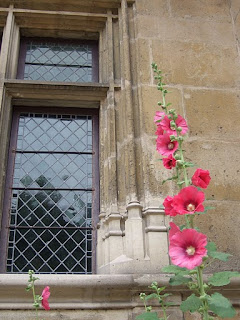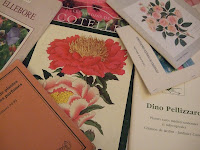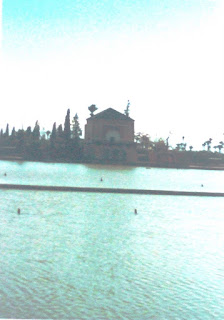Spring suits Proust. The gentle breeze turns over the pages, the warm sun heats the words and they bloom, careful, polite and plentiful. They fall down beyond the paper running after each other, burning and exploding. It is “Combray”: an imagined village, somewhere in the North of France, with dark streets named after medieval Saints and a slow, uneventful life that hinges around the steeple of its church. Chimes scan the holiday days of the narrator at his aunt Leonie’s house. Their tran-tran is described with long sentences and minute descriptions that seem lose themselves in a casual order, sometimes exasperating. On the contrary, no episode or detail is useless or superfluous: a careful plan supported by a solid literary theory, link them and it is developed in the nine volumes that compose A’ la Recherche du temps perdu. Combray is the first of the three books grouped under the title of Du côté de chez Swann. Released in 1913 by the French editor Grasset at Proust’ own expenses, this is the first volume of the Recherche.
The narrator describes his morning visits to aunt Leonie, who confined herself in two rooms owing to inexistent diseases and eccentric ideas, and the respectful visits of the priest, who kept her informed about the life in the parish. The cake bought after the Mass on Sunday morning, and the troubles and the gossips with the servants. The long evening talks with Monsieur Swann, and the walks in the country. Uncertain weather or late leavings addressed him, at that time a child, with his father and grandfather, towards Méséglise-la Vineuse, or the Swann’s side because, during the walk, they passed his property. Otherwise, they walked towards the Guermantes’s house, along the small river of the Vivonne with fresh, transparent waters. The rich bourgeois, whose daughter Gilberte make him feel in love for the first time, or the nobles, whose name opened a world of mighty suggestions. Two families and two different worlds, whose story ends, in the last volume of the Recherche, a few years after the end of the First World War.
The perfume of faded lilacs, the nasturtium scattered along the alley towards M.Swann’s villa, the hedge of hawthorn or the buttercups and the water lilies floating on the water of the Vivonne.
« … les boutons d’or. Ils étaient fort nombreux à cet endroit qu’ils avaient choisi pour leurs jeux sur l’herbe. Isolé, par couple, par troupes, jaunes comme un jaune d’œuf, brillants d’autant plus, [...] Les bras vers eux sans pouvoir épeler complètement leur joli nom de Princes de contes de fées françaises, venus peut-être il y a bien des siècles d’Asie mais apatriées pout toujours au village contents du modeste horizon, aimant le soleil et le bord d’eau, fidèles à la petite vue de la gare, gardant encore pourtant comme certaines de nos vieilles toiles peintes, dans leur simplicité populaire, un poétique éclat d’orient. »
“..the buttercups. They were numerous in the place they had chosen for their plays in the grass. Alone, coupled, trouped, yellow like the yellow of the egg, and glossier […] My arms towards them, I was unable to spell their pretty name of Princes of French fairy tales, they came from Asia maybe long time ago, but now belong to the village for ever, happy of this modest horizon, loving the sun and the banks of the river, loyal to the small sight of the station, still keeping, as our old paintings, in their popular simplicity, an oriental poetic splendour…”
Flowers attracted the narrator and he observed them, stopping in front of buzzing walls during his walks. He analyzed their shape and colour, their perfume and attitude: how they lean out curious in a shaded spot or, not invited, lengthen their supple branches against the church front. He perceived a hidden secret, but he was not able to reveal it.
Proust described flowers with the accuracy of a botanical, checking times of flowering and the hue of a petal, and the eye of a painter. He painted with accurate words borrowed from the religious and architectural vocabulary. They give shape and substance. They return more then just pleasant scenery and a conventional beauty, but a transfigured reality where flowers have intentions and thoughts, human temper and magic powers. They are oriental princesses, exotic houri and spring nymphs, metaphors that, bringing nearer different worlds, reveal new and deeper meanings.
Wild nature welcomed the narrator in its leafy, damp and shiny green world as he rushed out after long hours of reading. Jumps and shouts expressed the exaltation and compressed energy he has accumulated. Alone, in a shelter spot, he spent his days in reading and dreaming, plunged in a life that was more real and fascinating than his own. Many pages are dedicated to books both as a reading pleasure and as a spasmodic desire to be a writer. They were not just emotions and adventures, but a key to understand Beauty and Truth, to take possession of universal, higher thoughts, as just a sensitive, fanciful, bored and arrogant young mind can believe possible. Sometimes, there was a kind of rage in his runs that he vented beating innocent branches: it was a desire, a pleasure he satisfied alone in a closed room invaded by the scent of iris.
Proust spent his life among books: writing, translating and commenting. He thought they lead us to the threshold of our spiritual life. Here, every one has to continue alone. They can help us to develop our spirit but not to substitute it with a truth someone else has elaborated. Du coté de chez Swann was the natural development of another book he never finished, Contre Saint-Beuve. Here, he demolished the literary theory of a famous literary critic for his own’. Books and flowers are but parts of this theory.
Flowers awakened his sensitiveness, his desire to find suitable words to describe them and all the sensations they reminded. Mere intelligence is not enough, instinct gives the direction and this leads inside himself. The hidden correspondences between unsuspicious objects and our mind, so called unintentional memories, conspire to awake our memories. The past that then emerges has a special value, has the taste of true life, a taste that just literature can reveal. Otherwise, it will be lost forever.
Flowers haunted the book from the very first pages. The taste of a Madeleine, a soft biscuit, casually dipped in a cup of tea in a cold day brought back those days:
« …toutes les fleures de notre jardin et celles du parc de M.Swann, et les nymphéas de la Vivonne, …tout cela qui prend forme et solidité, est sorti, ville et jardins, de ma tasse de thé .. »
« … all the flowers of our garden and those of Mr.Swann’s park and the water-lilies of the Vivonne,… all that gets shape and solidity, is coming out, towns and gardens, from my cup of tea. »
To translate that world that urged inside him Proust lived isolated, for the last years, in a dark cork-lined apartment, threatened by a declining health. He used so many words to create pictures that escape from the pages to flow in your mind leaving ineffaceable traces. He closed the door and wrote because:
«.. les livres sont l’œuvre de la solitude et les enfants du silence . Les enfants du silence ne doivent rien avoir de commun avec les enfants de la parole, les pensées nées du désir de dire quelque chose, […] la matière de nos livres, la substance de nos phrases doit être immatérielle...»
. Les enfants du silence ne doivent rien avoir de commun avec les enfants de la parole, les pensées nées du désir de dire quelque chose, […] la matière de nos livres, la substance de nos phrases doit être immatérielle...»“…books are the work of solitude and the children of silence. The children of the silence have nothing to do with the children of words, thoughts born from the desire to say something… the matter of our books, the substance of our sentences has to be immaterial.”
He died in November, when nothing but memories could bring back the joy of spring flowers.




































